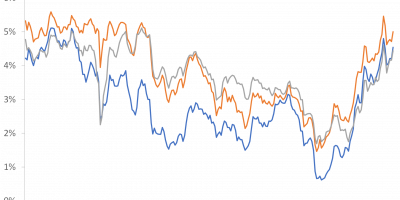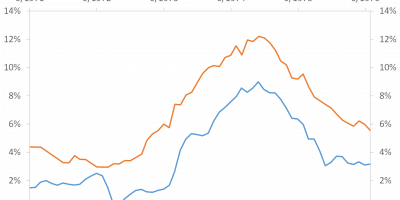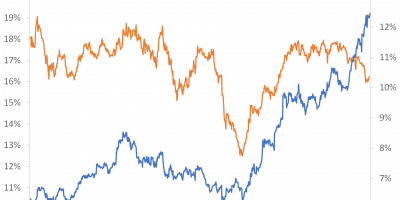My book – From Main Street to Wall Street (link) – has been published. This blog post explains why I wrote the book and its contents. The next three posts (that will be sent out in due course) will present some of the analyses and conclusions from the book.
Background
Let me start in 2008. The financial crisis was at its worst.
I was a young professor of finance. I studied financial crises (my Ph.D. is on currency crises) and the relation between the macroeconomy and expected stock returns.
One day, I was invited to a TV program. I was asked to explain something in relation to the crisis. I do not remember the exact topic, but the appearance revealed that I have an ability to explain complicated financial issues in simple terms. There was a need for people with such skills, as many found it difficult to understand what was going on during the financial crisis. I decided that it was part of my duty as a professor at a publicly funded university to help people understand the complicated interactions between the financial sector and the real economy that were brought to surface during the financial crisis. Back then, I became something like an “academic TV star” in Denmark.
A couple of years after the crisis, in 2012, the then Danish government established a commission. Its task was to evaluate the causes and consequences of the financial crisis in Denmark. Due to my presence in the Danish debate and my research on this area, I was asked to be its chairman. I accepted the offer.
The next couple of years, I worked day and night. The report – today called the “Rangvid-report” (link) – was published in autumn 2013.
The decision to write a book
At some point in 2015, or was it 2016, i.e. a couple of years after the report, I started talking to myself about my next big project. With “project financial crisis” completed, I felt I somehow needed a new project. I decided to write a book.
I did not want to stress myself. I have been writing when time has allowed it. Sometimes, I have been able to write a lot. At other times, several months have passed when I was not able to write anything. This has been fine. No stress. In fact, an enjoyable process.
What should its topic be? The obvious topic would have been the financial crisis, given my involvement here. But, as mentioned, I had just completed writing the report of the financial crisis, and everybody else were writing books on the financial crisis. It should be something different.
I am and always have been fascinated by financial economics. Economic growth determines so many things in life. Financial markets help people fulfill some of their big dreams: buy a house, save for retirement. I have done research on the relation between the macroeconomy and financial markets. I decided the book should deal with this.
I am an empirical economist. I have done formal theory when I was young, but I have to come to realize that I do not have a comparative advantage here. Hence, I wanted the book to be a fact-based book on the relation between the economy and financial markets.
I started investigating the market. I was surprised.
Every day, newspapers and business magazines cover the latest macroeconomic news, not least to help investors navigate financial markets. Is falling unemployment good for stocks because it indicates the economy is doing well? Or, is it bad because the central bank will then start tightening monetary policy, potentially hurting stocks? Will countries expected to grow fast provide higher returns? How will economic developments affect financial markets?
Given the attention academics and investors devote to understanding the economy and its impact on financial markets, it was somewhat surprising to me that no well-known book focusing on the relation between the economy and the stock market, and targeted towards a broader audience, existed. I decided that my book should aim at filling this gap.
Of course, there are related books. The one closest to mine is probably “The long good buy” by Peter Oppenheimer (link). I like to think that my book is more thorough and has a firmer anchoring in the academic theories, given my background as an academic and Oppenheimer’s as a practitioner. Also, my book has this structure with the long and the shorter run. Lastly, and probably most importantly, I carefully explain how we can use the insights from the theories and historical evidence to formulate predictions about the future. This being said, Oppenheimer’s book is a great extra reading if you are interested in these topics.
Other related books could be “Stocks for the Long Run” by Jeremy Siegel (link), “Expected Returns: An Investor’s Guide to Harvesting Market Rewards” by Antti Ilmanen (link), and “Financial Markets and the Real Economy”, edited by John Cochrane (link). These are all great books, but they cover different aspects of the topic. Siegel’s book is a description of the stock market on the long run, whereas my book relates the stock markets to the underlying economy, over the short and the long run. “Expected Returns” focuses on providing a comprehensive overview of theories of expected returns on different asset classes, whereas my book focuses on the relation between the macroeconomic and equity markets, over the long run and the business cycle. “Financial Markets and the Real Economy” is a collection of academic articles written by many different authors, i.e. it serves a very different purpose and targets a very different audience than my book, even when the title indicates the same topic.
Writing style
The book is written in a style similar to this blog. Of course, this is a blog, so my language here is sometimes less formal than what I use in the book, but the use of tables and figures to provide a fact-based background to the relation between financial markets and the economy is similar to this blog.
I decided that my book should be academic in nature, but written in a style that is accessible to a broader audience. For instance, the book does not contain formulas or equations, except like “Real equity returns = Nominal equity returns – inflation, “Equity returns = dividend yield + capital gains”, and the like. The book presents the academic theories relating to the different topics, but in a way that should be understandable for interested non-academic readers and students.
An important characteristic of the book is its reliance on the data. Figures and tables richly illustrate and back up arguments and theories. The book is empirical in nature.
I wanted the book to be reasonably comprehensive. Its purpose is to give the reader a thorough understanding of how economic activity affects equity returns. Also, in some chapters, equity returns are compared to interest rates and bond returns.
All chapters end with a checkpoint list that summarizes key insights.
Table of Contents
A guiding principle in the book is that movements in economic activity contain a long-run and a business-cycle component. Over the long run, economies grow. Over shorter horizons – over the business cycle – economic activity fluctuates. My book examines both the long-run relation between economic growth and stock returns as well as the business-cycle relation.
After a first part that introduces fundamental stylized facts and important concepts, the remaining parts of the book are structured around the long-run and short-run relations. In my book, the long run refers to multiple years or decades. The short run to months or a few years.
Over the long run, economies grow. The rate at which an economy grows over the long run is the determinant of whether a country is rich or poor. Expectations to developments in economic activity over the long run help us formulating expectations to returns from financial assets over the long run. When a 25-year old individual asks how much he/she should save to live a decent life after retirement, i.e. after many years, the answer will not least depend on what we expect financial assets to return over the next many years. And, the answer to that question in turn depends on how fast we expect economy activity to grow over the long run. The second part of this book explains what we know about long-run economic growth, about returns on stocks over the long run, and about the relation between long-run economic growth and stock returns.
Over the short run, economic activity fluctuates. Sometimes even substantially so. There are years when the economy is booming, unemployment is low, and times are good. At other times, in recessions, economic activity falls, people are laid off, and times are rough. The recurrent alternations between good times and rough times is the business cycle. Economic activity and the stock market share a common business-cycle pattern. The level of economic activity and the value of stocks rise and fall jointly throughout the business cycle. In order to understand why stock returns are sometimes high and why they are sometimes low, it helps to understand business-cycle fluctuations in economic activity. The third part of the book explains how economic activity and stock returns stocks are related over the business cycle. This part also describes monetary policy, as monetary policy plays an important role in understanding business-cycle fluctuations and stock markets. This part of the book also devotes one chapter to the financial crisis of 2008-2009, as an example of an economic and financial event that dramatically influenced economic activity and equity markets.
When we understand how economic activity relates to financial assets, over the long run and business cycles, we are better equipped to formulate expectations to future returns on financial assets, over the short run and over the long run. This is what the fourth part of the book deals with. It explains how economists judge the outlook for the economy, and it takes us through short-run and long-run stock-return predictability. I emphasize that there is considerable uncertainty surrounding return forecasts, but also that stock returns contain a small degree of predictability. Even if it seems small at first glance, it accumulates and has important implications for academics and practitioners alike.
A final, short, section contains my view on a few practical investment advices.
Publication process
Oxford University Press is the publisher of the book. OUP has done a great job setting up the book. It looks good. The cover is also cool. I am happy.

I handed in the manuscript in spring last year, right before corona arrived. This means that I did not manage to include a chapter on the corona-crisis. If there ever will be a second edition, it will include such a chapter. Until then, many posts on this blog describe different aspects of how the corona-crisis has affected the economy and stock markets.
I received the book in print a couple of weeks ago. It is a nice feeling having published a book.
Conclusion
This post has provided some background on why I wrote From Main Street to Wall Street and its contents. My next three posts will describe some of its key conclusions. The first post will be on the long-run relation between the economy and the stock market, the next on the business-cycle relation, and the final on how we can use those relations to say something about expected future returns.


